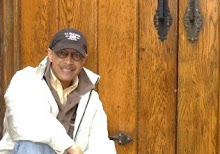 Some princes are born in palaces. Some are born in mangers. But a few are born in the imagination, out of scraps of history and hope. Barack Obama never talks about how people see him: I'm not the one making history, he said every chance he got. You are. Yet as he looked out Tuesday night through the bulletproof glass, in a park named for a Civil War general, he had to see the truth on people's faces. We are the ones we've been waiting for, he liked to say, but people were waiting for him, waiting for someone to finish what a King began.
Some princes are born in palaces. Some are born in mangers. But a few are born in the imagination, out of scraps of history and hope. Barack Obama never talks about how people see him: I'm not the one making history, he said every chance he got. You are. Yet as he looked out Tuesday night through the bulletproof glass, in a park named for a Civil War general, he had to see the truth on people's faces. We are the ones we've been waiting for, he liked to say, but people were waiting for him, waiting for someone to finish what a King began.Barack Hussein Obama did not win because of the color of his skin. Nor did he win in spite of it. He won because at a very dangerous moment in the life of a still young country, more people than have ever spoken before came together to try to save it. And that was a victory all its own.
An election in one of the world's oldest democracies looked like the kind they hold in brand-new ones, when citizens finally come out and dance, a purple-thumb day, a velvet revolution. A hundred thousand people came out in red states to hear Obama; a hundred fifty thousand turned out in purple ones, even after all this time, when they should have been sick to death of Hope and Change. In Michigan, people put an electric fence around their yard sign to protect it. NASA astronauts on board the International Space Station sent a video message encouraging people to vote; they did, from 200 miles up. A judge in Ohio ruled that homeless people could use a park bench as their address in order to register. A couple flew home from India just to cast their ballots. Obama's Ohio volunteers knocked on a million doors on Monday alone. That night, a Florida official locked himself in the Seminole County election headquarters and slept overnight with the ballots to make sure nothing went wrong with the vote. Early-voting lines in Atlanta were 10 hours long, and still people waited, as though their vote was their most precious and personal possession at a moment when everything else seemed to be losing its value. You heard the same phrases everywhere. First time ever. In my lifetime. Whatever it takes.
When it was over, more than 120 million pulled a lever or mailed a ballot, and the system could barely accommodate the demands of Extreme Democracy. Obama won more votes than anyone else in U.S. history, the biggest Democratic victory since Lyndon Johnson crushed another Arizona Senator 44 years ago. Obama won men, which no Democrat had managed since Bill Clinton. He won 54% of Catholics, 66% of Latinos, 68% of new voters — a multicultural, multigenerational movement that shatters the old political ice pack. He let loose a deep blue wave that washed well past the coasts and the college towns, into the South through Virginia and Florida, the Mountain West with Colorado and New Mexico, into the Ohio Valley and the Midwestern battlegrounds: you could almost walk from Maine to Minnesota without getting your feet wet in a red state. After months of mapmaking all the roads to 270, Obama tore right past with ease.
A nation doesn't much need a big President in small times; it needs one when the future is spitting out monsters. We've heard so much about Obama's brand-new voters that we easily forget the others he found, the ones who hadn't voted since Vietnam or who had never dreamed they'd vote for a black man or a liberal or a Democrat, much less all three. But many Americans are living through the worst decade of their lives, and they have anger-management issues. They saw a war mismanaged, a city swallowed, now an economy held together with foreign loans and thumbtacks. It took a perfect storm of bad news to create this moment, but even the big men rarely win in a walk. Ronald Reagan didn't. John Kennedy didn't. Those with the clearest vision often have to fight the hardest for others to see things as they do. Find out more about America's President-elect in a video biography at: http://video.google.com/videoplay?docid=3545343528928314588
Research info gathered at: http://www.time.com/
Now, here's one of my poems still stuck in the ballot box:
Enclosee Please Find
An umbrella hanging in the hallway.
A noisy vending machine with a quick temper.
Circles drawn in a mirror with red lipstick.
Tar melting on a hot tin roof.One innocent knife.
Some shy bullets.
The moat of a former castle.
Ordinary white underwear.
A persistent fire alarm.
Toy trains emitting real puffs of smoke.
War right after it declares a truce.
A copper skillet with it own cleaning instructions.
Brightly colored canisters of embalming fluid.
8x10 pictures of a single apple ripening.
A meadow thick in a woman of flowers.
Poem first published at: http://kenagainfreesavers.com/
Visit my ezine: http://www.concelebratory.blogspot.com/
tutoring blog: http://www.miceintheclassroom.blogspot.com/
and music blog: http://www.medleyamkersant.blogspot.com/
Poem copyright 2008 by Maurice Oliver. All Rights Reserved.






